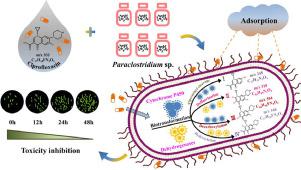Water Research ( IF 11.4 ) Pub Date : 2021-01-05 , DOI: 10.1016/j.watres.2021.116808 Heting Fang , Akashdeep Singh Oberoi , Zhiqing He , Samir Kumar Khanal , Hui Lu

|
Ciprofloxacin (CIP), one of the most widely used fluoroquinolone antibiotics, is frequently detected in the effluents of wastewater treatment plants and aquatic environments. In this study, a CIP-degrading bacterial strain was isolated from the sulfate reducing bacteria (SRB)-enriched sludge, identified as Paraclostridium sp. (i.e., strain S2). The effects of critical operational parameters on CIP removal by the strain S2 were systematically studied and these parameters were optimized via response surface methodology to maximize CIP removal. Furthermore, the pathway and kinetics of CIP removal were investigated by varying the initial CIP concentrations (from 0.1 to 20 mg/L). The CIP removal was characterized by rapid sorption followed by biotransformation with a specific biotransformation rate of 1975.7 ± 109.1 µg/g-cell dry weight/h at an initial CIP concentration of 20 mg/L. Based on the main transformation products, several biotransformation pathways have been proposed including piperazine ring cleavage, OH/F substitution, decarboxylation, and hydroxylation as the major transformation reactions catalyzed by cytochrome P450 and dehydrogenases. Acute toxicity assessment apparently shows that CIP biotransformation by strain S2 resulted in the formation of less toxic intermediates. To the best of our knowledge, this is the very first study in which a key functional microbe, Paraclostridium sp., highly effective in CIP biotransformation, was isolated from SRB-enriched sludge. The findings of this study could facilitate in developing appropriate bioaugmentation strategy, and in designing and operating an SRB-based engineered process for treating CIP-laden wastewater.
中文翻译:

环丙沙星降解Paraclostridium SP。硫酸盐还原菌富集污泥中分离:优化及机理
环丙沙星(CIP)是最广泛使用的氟喹诺酮抗生素之一,经常在废水处理厂和水生环境的废水中检测到。在这项研究中,从富含硫酸盐还原细菌(SRB)的污泥中分离出了一种降解CIP的细菌菌株,鉴定为副梭菌sp。(即,菌株S2)。系统研究了关键操作参数对菌株S2去除CIP的影响,并通过响应面方法对这些参数进行了优化,以最大程度地去除CIP。此外,通过改变初始CIP浓度(从0.1到20 mg / L)研究了CIP去除的途径和动力学。CIP去除的特征是快速吸附,然后在初始CIP浓度为20 mg / L时以特定生物转化速率1975.7±109.1 µg / g细胞干重/ h进行生物转化。基于主要的转化产物,已提出了几种生物转化途径,包括哌嗪环裂解,OH / F取代,脱羧和羟化反应,这是细胞色素P450和脱氢酶催化的主要转化反应。急性毒性评估显然表明,菌株S2对CIP的生物转化导致毒性较低的中间体的形成。据我们所知,这是第一个有关关键功能微生物的研究,从富含SRB的污泥中分离出对CIP生物转化非常有效的副梭菌属。这项研究的发现可能有助于制定适当的生物强化策略,并设计和运行基于SRB的工程方法来处理CIP负载的废水。











































 京公网安备 11010802027423号
京公网安备 11010802027423号